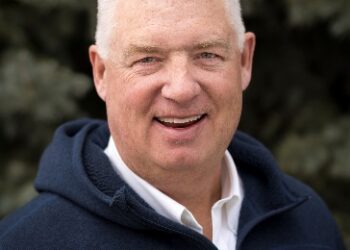By Amanda Eggert EBS Staff Writer
BIG SKY – Approximately 395,000 people die of cardiac arrest in the U.S. each year, a medical emergency with a 5 percent survival rate, according to Montana EMS and Trauma Systems.
In October, two Spanish Peaks Mountain Club security personnel responded to a cardiac arrest with a positive outcome. They administered CPR and used an automatic external defibrillator, or AED, to keep the patient alive, which allowed the Big Sky Fire Department to provide advanced life-support care.
During the Big Sky’s inaugural Cardiac Ready Communities meeting on Dec. 16, the two men who responded to the incident – Charles Johnson and Brian Keanum – received certificates of appreciation from BSFD Chief William Farhat.
“If you have trained people ready to assist and if you have an AED around, you truly can save lives,” Farhat said on Jan. 5. “It’s important that people seek out the training and learn how to use the AEDs that are located around the community, because they can make a difference, as proven in October.”
In contrast to a heart attack, where someone can experience symptoms for several hours and survive, cardiac arrest patients often die within minutes if they don’t receive the appropriate care immediately.
“Cardiac arrest is an immediate emergency,” said Janet Trethewey, Montana’s Cardiac Ready Communities Program Manager. “You’ve got a couple minutes before the brain and heart have died because they’re not getting any oxygen.”
Cardiac arrest is an electrical or wiring problem in the heart, Trethewey says, and some people are predisposed to it due to abnormal heart development. A number of situations can trigger a life-threatening incident in the predisposed, including exercise, stress and even cold air.
The survival rate for someone who is defibrillated within one minute of cardiac arrest onset is 90 percent, according to Trethewey. Survival rates fall to 50 percent if defibrillation doesn’t occur within five minutes and after nine minutes only 10 percent of patients survive.
Trethewey aims to increase survival rates by educating Montana communities about the symptoms and treatment of cardiac arrest. Within seconds of experiencing an irregular heart rhythm, a cardiac arrest patient typically becomes unresponsive, stops breathing, or is gasping for air, she said.
CPR – which should be administered until an AED is located – can keep oxygenated blood moving through the patient’s body.
Recommended protocol for CPR has changed in recent years. Previously, organizations like the American Heart Association suggested delivering rescue breaths in between compression cycles; now the AHA recommends hands-only CPR.
“Nationwide, they’re finding that if they teach people to just do compressions, they’re more likely to step up and do it,” Trethewey said, adding that it “removes that ick factor of having to breathe for somebody” and people remember the steps better.
Effective compressions should depress the chest of an adult patient at least 2 inches at a rate of 100-120 compressions per minute, according to AHA guidelines. An AED shock should be administered as quickly as possible.
“[Defibrillation] has to happen very quickly or the electrical activity has diminished to the point where the shock won’t work,” Trethewey said.
Farhat said approximately 18 AEDs are located in and around Big Sky.
These locations include the post office, fire station, Lone Mountain Ranch, Buck’s T-4, the Whitewater Inn, Roxy’s Market, and the Big Sky Chamber of Commerce. There are a total of eight AEDs stationed in Ophir Elementary and Lone Peak High schools, and every Gallatin County Sheriff’s vehicle is equipped with one.
Stephen Pruiett, who handles Emergency Medical Systems training at the Big Sky Fire Department, says a patient’s survival results from quick action during every step of a medical response.
“It’s all about improving each link in the cardiac arrest chain of survival: recognition, activation, early CPR and AED, along with getting advanced [care],” Pruiett said.












